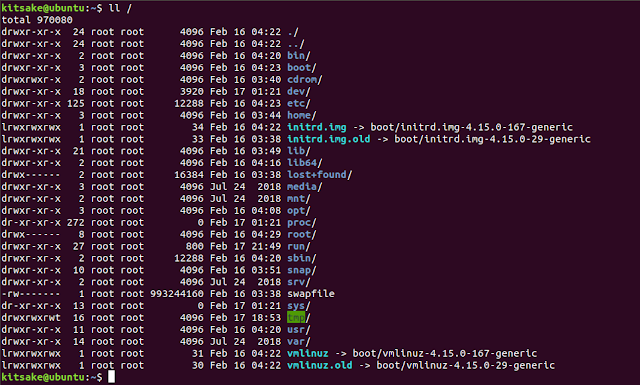Overview of File System Hierarchy Standard (FHS) on Ubuntu
%20on%20Ubuntu.webp) |
| Overview of File System Hierarchy Standard (FHS) on Ubuntu |
Overview of File System Hierarchy Standard (FHS) on Ubuntu - The Linux file system has a tree structure whose root (root) is represented by the '/' character which in turn contains other system subdirectories.
Let's now see the most significant subdirectories to understand the meaning of their names and familiarize ourselves with the filesystem.
 |
| File System Hierarchy Standard |
1. /
/ - is the root directory of the filesystem, all others are sub-directories.
2. /bin
/bin - Contains binary binary format executables.
3. /boot
/boot - Within this directory, we find the kernel image (vmlinuz), the ramdisk image for module preloading of block devices, the kernel configuration file, and the GRUB boot loader configuration files.
4. /dev
/dev - Contains the files necessary for the system for addressing devices.
5. /etc
/etc - Contains all system, device, service, account, password, boot, network, and other configuration files.
6. /home
/home - By default the directory where the home dirs of system users reside.
7. /lib
/lib - As the name implies, this contains libraries that can be used by executable files and the kernel.
8. /mnt
/mnt - It is the directory used for the mount point of removable devices such as cd-rom, floppy drivers, usb pendrive, etc.
9. /media
/media - Like mnt, it represents the mount point of removable devices such as cd-rom, floppy drivers, usb pendrive, etc.
10. /opt
/opt - Usually contains user-installed programs or third-party software.
11. /proc
/proc - Contains several subdirectories that contain system-created files reporting system and kernel statistics.
12. /root
/root - The home directory of the root or system administrator.
13. /sbin
/sbin - Here we find all system executables and programs that can only be used by the root user (super-user) for system management and administration.
14. /tmp
/tmp - Contains temporary files created by the system and applications. Almost all distributions clean up some of the files it contains at system startup.
15. /usr
/usr - This directory contains programs that can be used by all users, commands and administrative utilities and is certainly one of the most important as much of the system resides there. Looking at the contents of this one, you immediately notice that it looks a lot like the / directory in that it contains the directories bin, etc, lib, sbin, etc. Let's analyze the most important subdirectories.
 |
| /usr |
- /usr/include - Here are the header files used by the C compiler.
- /usr/local - A good sysadmin installs their software here.
- /usr/man - Contains the system manual available via the man command argument.
- /usr/share - Contains some files called by system applications.
- /usr/X11R6 - Contains the X11 system graphics manager software.
16. /var
/var - This is the so-called variable data directory. Here system programs record runtime information, create cache, user control, and spool files.


Post a Comment for "Overview of File System Hierarchy Standard (FHS) on Ubuntu"
Post a Comment